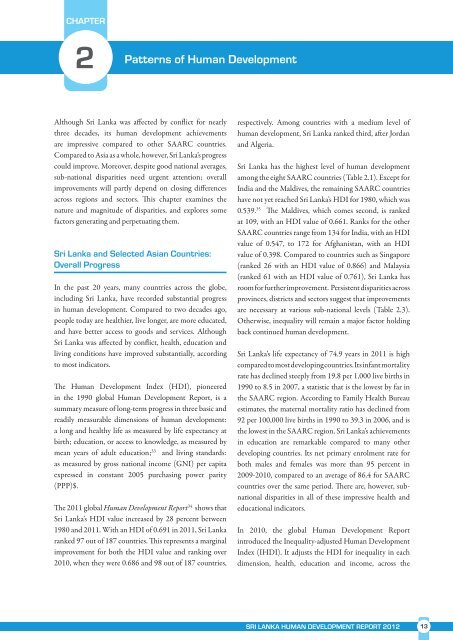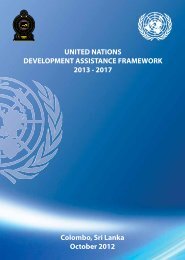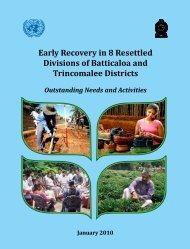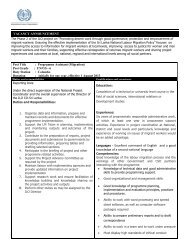Sri Lanka Human Development Report 2012.pdf
Sri Lanka Human Development Report 2012.pdf
Sri Lanka Human Development Report 2012.pdf
You also want an ePaper? Increase the reach of your titles
YUMPU automatically turns print PDFs into web optimized ePapers that Google loves.
CHAPTER<br />
2<br />
Patterns<br />
of <strong>Human</strong> <strong>Development</strong><br />
Although <strong>Sri</strong> <strong>Lanka</strong> was affected by conflict for nearly<br />
three decades, its human development achievements<br />
are impressive compared to other SAARC countries.<br />
Compared to Asia as a whole, however, <strong>Sri</strong> <strong>Lanka</strong>’s progress<br />
could improve. Moreover, despite good national averages,<br />
sub-national disparities need urgent attention; overall<br />
improvements will partly depend on closing differences<br />
across regions and sectors. This chapter examines the<br />
nature and magnitude of disparities, and explores some<br />
factors generating and perpetuating them.<br />
<strong>Sri</strong> <strong>Lanka</strong> and Selected Asian Countries:<br />
Overall Progress<br />
In the past 20 years, many countries across the globe,<br />
including <strong>Sri</strong> <strong>Lanka</strong>, have recorded substantial progress<br />
in human development. Compared to two decades ago,<br />
people today are healthier, live longer, are more educated,<br />
and have better access to goods and services. Although<br />
<strong>Sri</strong> <strong>Lanka</strong> was affected by conflict, health, education and<br />
living conditions have improved substantially, according<br />
to most indicators.<br />
The <strong>Human</strong> <strong>Development</strong> Index (HDI), pioneered<br />
in the 1990 global <strong>Human</strong> <strong>Development</strong> <strong>Report</strong>, is a<br />
summary measure of long-term progress in three basic and<br />
readily measurable dimensions of human development:<br />
a long and healthy life as measured by life expectancy at<br />
birth; education, or access to knowledge, as measured by<br />
mean years of adult education; 33 and living standards:<br />
as measured by gross national income (GNI) per capita<br />
expressed in constant 2005 purchasing power parity<br />
(PPP)$.<br />
The 2011 global <strong>Human</strong> <strong>Development</strong> <strong>Report</strong> 34 shows that<br />
<strong>Sri</strong> <strong>Lanka</strong>’s HDI value increased by 28 percent between<br />
1980 and 2011. With an HDI of 0.691 in 2011, <strong>Sri</strong> <strong>Lanka</strong><br />
ranked 97 out of 187 countries. This represents a marginal<br />
improvement for both the HDI value and ranking over<br />
2010, when they were 0.686 and 98 out of 187 countries,<br />
respectively. Among countries with a medium level of<br />
human development, <strong>Sri</strong> <strong>Lanka</strong> ranked third, after Jordan<br />
and Algeria.<br />
<strong>Sri</strong> <strong>Lanka</strong> has the highest level of human development<br />
among the eight SAARC countries (Table 2.1). Except for<br />
India and the Maldives, the remaining SAARC countries<br />
have not yet reached <strong>Sri</strong> <strong>Lanka</strong>’s HDI for 1980, which was<br />
0.539. 35 The Maldives, which comes second, is ranked<br />
at 109, with an HDI value of 0.661. Ranks for the other<br />
SAARC countries range from 134 for India, with an HDI<br />
value of 0.547, to 172 for Afghanistan, with an HDI<br />
value of 0.398. Compared to countries such as Singapore<br />
(ranked 26 with an HDI value of 0.866) and Malaysia<br />
(ranked 61 with an HDI value of 0.761), <strong>Sri</strong> <strong>Lanka</strong> has<br />
room for further improvement. Persistent disparities across<br />
provinces, districts and sectors suggest that improvements<br />
are necessary at various sub-national levels (Table 2.3).<br />
Otherwise, inequality will remain a major factor holding<br />
back continued human development.<br />
<strong>Sri</strong> <strong>Lanka</strong>’s life expectancy of 74.9 years in 2011 is high<br />
compared to most developing countries. Its infant mortality<br />
rate has declined steeply from 19.8 per 1,000 live births in<br />
1990 to 8.5 in 2007, a statistic that is the lowest by far in<br />
the SAARC region. According to Family Health Bureau<br />
estimates, the maternal mortality ratio has declined from<br />
92 per 100,000 live births in 1990 to 39.3 in 2006, and is<br />
the lowest in the SAARC region. <strong>Sri</strong> <strong>Lanka</strong>’s achievements<br />
in education are remarkable compared to many other<br />
developing countries. Its net primary enrolment rate for<br />
both males and females was more than 95 percent in<br />
2009-2010, compared to an average of 86.4 for SAARC<br />
countries over the same period. There are, however, subnational<br />
disparities in all of these impressive health and<br />
educational indicators.<br />
In 2010, the global <strong>Human</strong> <strong>Development</strong> <strong>Report</strong><br />
introduced the Inequality-adjusted <strong>Human</strong> <strong>Development</strong><br />
Index (IHDI). It adjusts the HDI for inequality in each<br />
dimension, health, education and income, across the<br />
sri lanka <strong>Human</strong> <strong>Development</strong> report 2012 13






